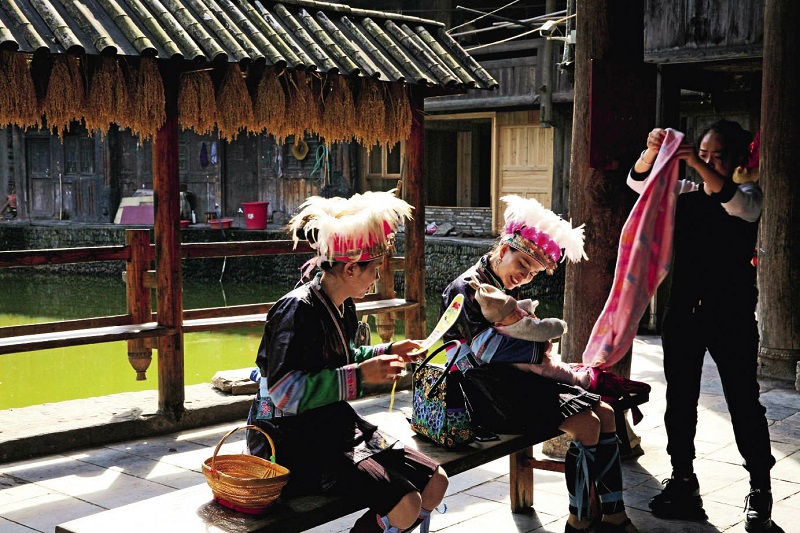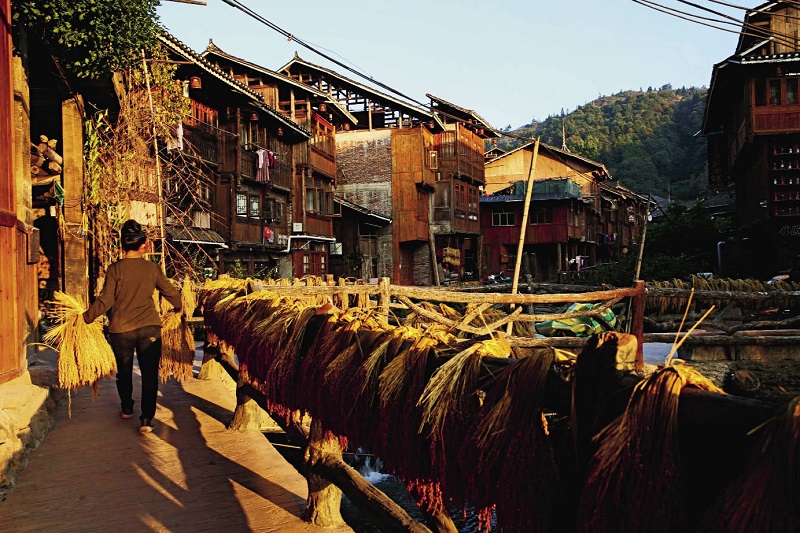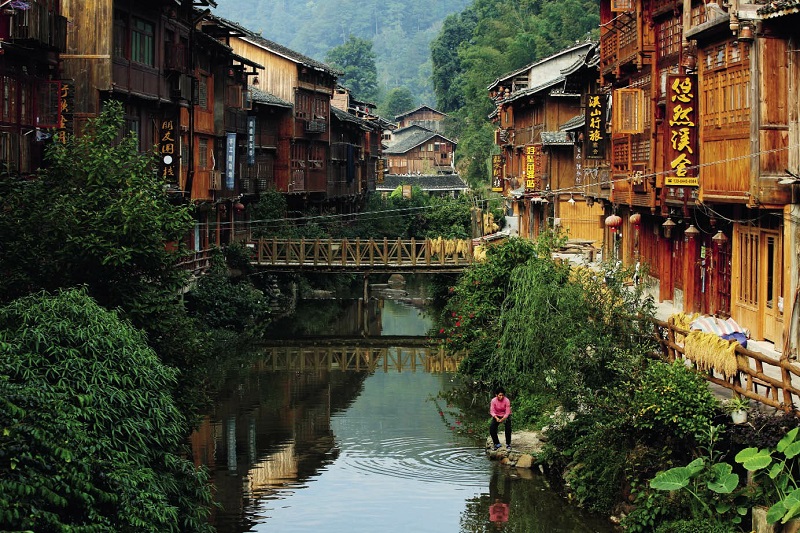Time Reflected in Music
Singing is an integral part of Dong culture. As soon as young children pick up the ability to speak, they are able to sing. Even when people are struggling to make ends meet to satisfy their basic daily necessities, they can still be heard singing, and when young men propose to their beloved, it is always done through songs. They have honed the ability to sing in multi-part harmony without instrumental accompaniment or a leader. Their repertoire includes imitative songs that test performers’ virtuosity at mimicking the sounds from nature, like the chirping of birds and insects, and the burbling of flowing water down the majestic mountains. In the music can be heard the sound of budding flowers and winds blowing through the valleys. This multi-part singing style of the Dong ethnic group is known as the Grand Song, and has a long history, dating back as far as the rhymed Song of the Yue Boatman written in the Spring and Autumn period (770-476 BC). It has evolved amid the changes of dynasties, and was inscribed in 2009 on the UNESCO’s Representative List of the Intangible Cultural Heritage of Humanity.
In contrast with the Grand Song performed in groups in large open spaces, the Song and Moon love ballads of the Dong people are romantic and personal, charming, and graceful. In the past, young Dong girls around the age of 15 to 16 began to meet in groups of 3-5 to sew, do embroidery, make shoe soles, and do other group activities, waiting for young men of their same age to come visit them. Young Dong men, on the other hand, also formed groups of their own and took instruments like the pipa, niutuiqin (a special bowed or plucked lute of the Dong ethnic people), or Dong flutes which they fashioned by hand themselves and went to where the young ladies gathered and did what can be translated as “teasing the young ladies” (meaning singing love songs in the hope of initiating a romantic relationship).
The location where the young men serenaded the young ladies was often the home of one of the ladies, which was usually large and spacious, and housed a large kindhearted and hospitable family. The young lady of the family usually invited her close friends over to chat and share notes about their romantic dreams while doing needlework. After the young men arrived, they all mingled socially, had fun together, and expressed their feelings for each other, most of which was done through playing musical instruments and singing love songs in antiphonal style. Quiet nights in a Dong village were often filled with people singing romantic love songs. While they sang, melodies played on the Dong flute flowed like a bubbling stream right into the young ladies’ hearts. Such parties often lasted until dawn. In addition to young ladies’ spacious homes, another location often used for this activity was a building referred to by locals as the “Moon Hall.” Some villages even opened up their special drum towers to young people for them to conduct their activities revolving around courtship.

Two young Dong ladies embroider shoe soles while taking care of a newborn.
Drum Towers Draw People Together
Drum towers are an identifying feature of Dong villages. Wherever there is a stockaded Dong village, there is a drum tower. A drum tower is an entirely wooden structure built in the shape of a cedar tree. The drum tower is the tallest building in every Dong village, and is named thus due to the presence of a drum within its confines. It is the traditional communal gathering place for every major celebration event or meeting. Usually, it is also a place where local villagers enjoy time meeting and interacting together and celebrating common festivals. Dong people’s culture is so closely related with drum towers that every major social activity is held under this roof, thus turning the drum tower into the embodiment of their culture. Dong culture has also been called the drum tower culture.
Inside each drum tower, four four-legged rectangular benches surround what is called the fire pond or fire pit in the middle inlaid with bluestone. There are four thick main pillars on each side of the fire pit that extend up to the roof, and 12 supporting pillars, representing four seasons and 12 months. The successive levels of the building structure scale up in a manner so as to leave the center open. The large open space around the drum tower is the public meeting area for the Dong people residing in the village.
The drum tower spiritually signifies prosperity, good luck, and unity; it is the symbol of the Dong ethnicity, their village and family name. Drum towers have quietly recorded each moment of the Dong people’s lives, from relaxed and sweet moments when young people are expressing their love in song for one another, to serious occasions when the elders of the village make major decisions. Wedding ceremonies and funerals are also held here, making it the place of collective joy, celebration, and sorrow for the village. Nevertheless, the original purpose of the drum tower in ancient history was to sound the alarm in case of an approaching invading enemy and call for help from surrounding villages.
The most festive period of the year here is the Sama festival. Sama is the name of a heroine in the ancient matriarchal society of the Dong people. On the day of the festival, the environment is very lively, and Dong people come together to remember this heroine and pray for a prosperous future and good harvests.
On both sides of the Zhaoxing River, stilt houses covered with small green tiles can be seen here and there arranged in no particular order. The climate here is warm in the winter and cool in the summer. The Dong people have lived by the quiet river for many generations. Between houses occasionally lies an old guesthouse with a wooden placard bearing the inn’s name hung over the front entrance, making it quite eye-catching. Life along both sides of the river is quieter than that around the drum tower.
Flower Bridges that Permeate with Vitality
Traditional Dong style bridges are called wind and rain bridges or flower bridges because the Dong people build coverings over the bridges to provide shelter from wind and other extreme weather. Since the local people have lived by rivers for centuries, they have a rich culture of making various styles of bridges using different materials. There are stone arch bridges, stone slab bridges, bamboo bridges, and wooden bridges among others. They even go as far as cutting down a huge tree and using it as a bridge after simple treatment. The most culturally representative bridge style of the Dong people is the covered flower bridge. In addition to helping people cross back and forth over a river, this bridge also serves as a public place for people to get some rest, take shelter from rain, meet friends, and enjoy the surrounding scenery. Mengmao Flower Bridge in Zhaoxing features an ornate carving of two headstrong dragons playing with a bead on the top of the wind and rain porch on the bridge pavilion.
Beautifully decorated flower bridges are more than just a means of crossing the river. On a clear moonlit night where the sky is lit up with stars, the flower of youth begin to blossom on these bridges when young men and ladies express their love for each other through songs.
The ancient Tang’an Flower Bridge is relatively hidden among the terraced fields. Its beams and columns have turned emerald green having seen much moisture in rainy and foggy weather. The spring below the bridge continues to bubble underneath, while the bridge floor creaks when walked upon. On rainy and foggy days which occur from time to time, those traversing the village appear as if engulfed by magical clouds. On misty moonlit nights, the sound of singing can be heard drifting out from flower bridges hidden deep in the mist. People in the village sit around in twos and threes, and their witty yet sincere duets move people’s hearts.
Over the past few years, the instances of young men and women singing to each other have lessened gradually. Since there are no middle schools located in small and medium-sized villages in the region, most children aged around 15 or 16 have to leave their home to study at boarding schools, doing reading exercises in the morning and individual study in the evening. When they return home on weekends, they still have much homework to finish before returning to school the following Monday. As a result, they have no time to sing and hone their skills in their traditional style of music.

A woman lays out ears of rice to dry in the sun.
Food Is the Joy of Life
At around three o’clock in the morning every day, plumes of smoke begin to rise from homes throughout the village. Later after the smoke disperses, the air is filled with ashy aroma of burnt wood. There are piles of firewood neatly stacked in front of and behind each house. The Dong people greatly value firewood and that importance can be seen during the festivities of the first day of the new year. On that day, villagers put on a grand ceremony for firewood, during which they don new clothes, take a machete tied with a piece of red silk and go into the mountains to cut firewood, an activity also known as “harvesting firewood” (they consider collecting firewood as gaining wealth). Returning home with chopped firewood symbolizes that they have successfully returned home with much wealth. The arm’s length firewood is tied together in bundles with red ribbons and placed in the main room, the storage room and kitchen as a lucky omen of prosperity.
Guizhou is a mountainous area, and terraces on the slopes have their own unique features. The terraced fields around Tang’an Dong Village are beautiful beyond description. What distinguishes these terraced fields from other places is that their ridges are made of stone rather than earth. The slopes of the terraced fields of Tang’an are quite steep because the terrain here is steep and rocky, which makes it difficult to level large tracts of land. As a result, people put much care and effort into building stone terraced fields. According to elderly people in the village, the work of making a stone ridge must be conducted by one person alone, because the weight of too many people will cause the terrace to collapse.
On the mountain behind Tangan Village, there is a section of stone terraced fields which bear resemblance to the Great Wall. During the reign of Emperor Guangxu (1871-1908) in the Qing Dynasty (1644-1911), Pan Chuanda, a 61-year-old Tang’an ghostbuster, resolutely gave up his high paying job of ghostbusting which he had done for many years and decided to turn barren mountain into fertile land. For the next 12 years, he lived on the mountain, picked up rocks by himself, and finally completed this masterpiece of terraced fields at the age of 73. Today, after more than a century, this “Great Wall of Terraced Fields” still stands strong. The villagers pass by the fields day after day as they collect grass for their pigs and carry grain for their cattle. There is not much need for retelling this story, for the spirit of hard work that it exhibits has already become an inseparable part of their being.
ZHAO YANQING is a travel columnist.








